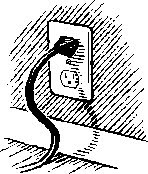Saturday, February 21, 2009
Electric Car Charging in San Francisco
But let's look at electric cars realistically. From the standpoint of efficiency, they're not better than the traditional internal combustion engine. Each car must be charged with electricity generated at a central station power plant. The average steam electric generating station in the U.S. is about 33% efficient. So two thirds of the energy used to generate a Kilowatt-hour is gone before it leaves the plant. In addition, losses on the transmission and distribution system (the wires that carry power) amount to up to 10% and the drive train of the vehicle, motors, electric power quality, etc. will likely reduce efficiency by a similar amount. Those additional reduction in efficiency, another 20%, reduces the electric car efficiency to around 26%. This is not much better than the internal combustion engine.
One can argue that we are reducing pollution. But are we? Or are we really displacing pollution. Every fossil-fuel burning power plant emits pollution of various kinds and amounts depending on the fuel used. What we do not endure from a tail pipe we still endure from a power plant stack. One can also argue that it's easier to control pollution from thousands of power plants rather than millions of cars and with that I agree. But is displacing the emissions from your vehicles to another community for the sake of your own air really fair?
Before the U.S. embarks on an all out electric car phase, the amount of infrastructure both in terms of power plants and millions, tens of millions, of charging stations should be examined very, very carefully. There has to be a benefit associated with the huge cost, not just the illusion of pollution reduction. Plus, if there's a black out, especially an extended one like the 2003 blackout of a large swath of the U.S., how will cars be charged? Is this potentially a national security issue?
There is a better way at this. One that is more efficient and ultimately pollution free. But that's for a future blog post.
Sunday, February 15, 2009
Sun + Fossil Fuel = Efficiency
I read an article (http://www.technologyreview.com/energy/22080/page1/) about how about using the heat of the sun can boost the efficiency of existing fossil fuel power plants. I thought this was an interesting concept to explore.
One type of power plants that is prevalent is called a combined cycle plant. It uses two different types of engines (cycles) to create electricity. One cycle is a combustion engine called a gas turbine or combustion turbine (Brayton Cycle) and the other is a steam engine or steam (Rankine) cycle. It is represented by the graphic (Source: Texas Utilities).
Let’s explain what’s going on here and how adding solar energy can improve the engine’s efficiency. Think of the Gas Turbine Cycle above as if it were an aircraft engine, which are also gas turbines. As you can see this engine drives an electric generator to create electricity. The exhaust gases from this engine are very hot, and if allowed to escape to the atmosphere, will dissipate and be of no use.
However, power plant designers have devised a way to capture and reuse this waste heat by running it through a boiler and powering a steam turbine cycle, represented at the bottom portion of the graphic above. Combined Cycle Power Plants are currently the most efficient way to create electricity.
So, how do we introduce the sun into this mix? In some combined cycle power plants, the boiler in the steam cycle is capable of being fired with additional fossil fuel, usually natural gas. This boosts the output of the plant during the peak times of the day when electricity use is at its highest. However, because it is firing additional fuel to obtain the increased output, it will usually be less efficient to do so. So why do it? The price of power is higher at the height of electric use or peak time of the day, so it is worthwhile to have reduced efficiency for additional plant output. Using heat provide by a solar collecting array eliminates the need for the additional fossil fuel.
Although sunlight may be free, the technology that turns sunlight it into steam is not. The power plant will have to build and pay for the solar array, but, as a result, over time the plant will produce more energy when it is most needed at a more predictable cost rather than the volatile and unknown expense of the displaced fossil fuel long into the future.
Sunday, February 8, 2009
BTUs and BLTs
Of course, the financial community today, thirty years later, is expert in all forms of energy and adept at financing projects of all kinds. However, the phrase that I coined so long ago has followed me, in a good way, all of this time. And according to the person I said it to, who has provided engineering consulting services around the globe and related it to his clients, says he has heard it translated into many languages, humorously.
I use it here because it is part of the light-hearted title of a book I'm writing about energy. As someone who has been associated with energy all of my career, I find that there is a lot of information and misinformation in the discourse about energy. My upcoming book and this blog, with constructive feedback and dialogue from those who visit here, will try to illuminate this subject so that we can all become more learned when it come to this most important resource and its impact on our economy and our lives.



